COVER STORY
Engineering takes diversity of its faculty to heart:
Why Cornell has become 'a better place to go' for many young professors
Richard Robinson, assistant professor of materials science and engineering, in his lab with graduate student Don-Hyung Ha, left, and postdoctoral associate Haitao Zhang. At one point, Richard Robinson considered becoming a bus driver. After all, as a middle-class African-American kid growing up in Indianapolis, he knew he had to do something – and it seemed a fine career. But as an eighth-grader, with the help of a National Science Foundation program aimed at minority students, Robinson discovered science and engineering. That was the spark that took him all the way to where he is today: a member of the Cornell University faculty in the College of Engineering. Robinson, an assistant professor of materials science and engineering who researches the chemistry and physics of nanoparticles for energy applications, is now part of his college's – and Cornell's – changing face. Before joining the faculty in 2008, he was courted by other institutions. Cornell's boldly stated commitment to diversity helped tip the scale in its favor. "It convinced me Cornell was a better place to go," Robinson says. "That's one of the reasons I came here – there is no question about that." Cornell, along with other top research universities across the United States, is facing a formidable challenge in the next five to 15 years. A third of its faculty is nearing retirement age, and as the university's Strategic Plan states, significantly increasing "the diversity of faculty through new hires and enhanced retention efforts" is paramount. Stated goals focus on "gender, racial and ethnic diversity" of faculty in all units. The College of Engineering set specific diversity targets in its own strategic plan, published in 2004. Under the leadership of then-dean, now Cornell's provost, Kent Fuchs, the plan set 2015 goals for increasing underrepresented minority faculty members to at least 7 percent and women faculty members to at least 20 percent. Lance Collins, dean of the College of Engineering, speaks to prospective students during the college's joint Prospective Candidates Weekend and Diversity Hosting Weekend in April. See larger image As of fall 2010, the college's 227-member faculty had 28 females, or 12 percent of the total; underrepresented minorities, 6 percent of the total, included seven African-Americans, six Hispanics and one Native American. There were also 28 Asians and Asian-Americans, which as a group are not underrepresented in engineering. In the College of Engineering, three racial and ethnic groups – African-Americans, Hispanics and Native Americans – fall under the definition of "underrepresented minorities." Nationally, women are also traditionally underrepresented in engineering. As of 2008, 10.8 percent of tenured or tenure-track faculty in engineering colleges at four-year U.S. institutions were women, according to the National Science Foundation's (NSF) most recent report on women in the sciences. The national situation with underrepresented minorities is also stark, with faculty representation in the engineering disciplines proportionally far below population figures. In 2006, African-Americans were 12.8 percent of the U.S. population; Hispanics, 14.8 percent; and Native Americans, 1.1 percent. According to a University of Oklahoma report, in 2007 underrepresented minorities were just 6.6 percent of faculty in civil engineering departments at top-tier institutions. Departments in other engineering disciplines fell even shorter.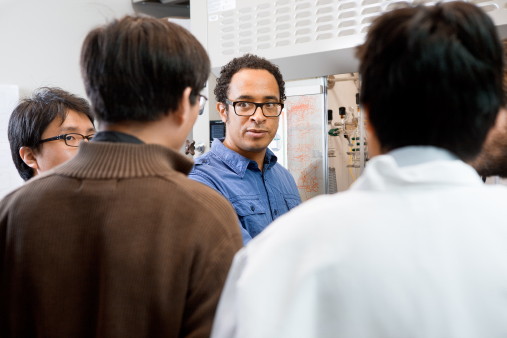
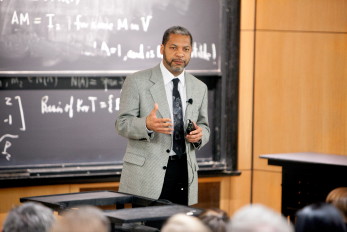
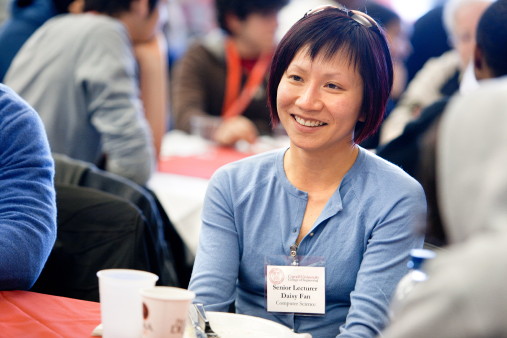
Daisy Fan, senior lecturer in computer science, speaks with prospective students.
Enhancing the diversity of faculty is important, in part, because a rapidly changing student population – an increase from approximately 25 percent in 2004 to 33 percent in 2010 among female undergraduates, and an increase from approximately 6 percent to 12 percent underrepresented minorities – requires a faculty that reflects its own demographic trends, say college leaders. But beyond that, says engineering dean Lance Collins, diversity will make the college a better, more vibrant, more intellectually rigorous place.
"In a world in which you can bring multiple viewpoints from different backgrounds together, that's a richer environment to be in, for students to grow up in, and for colleagues to interact with each other," says Collins, who is the college's first African-American dean. "If we are unsuccessful at increasing diversity at all levels, at some point that will erode and undermine our ability to be an outstanding institution."
For a glimpse into the future, Cornell's Department of Biomedical Engineering is one place to look.
The department, in some ways, is a "reflection of modern reality" – what engineering departments will look like 10-20 years hence, says Rick Allmendinger, professor of earth and atmospheric sciences who is the college's associate dean for diversity.
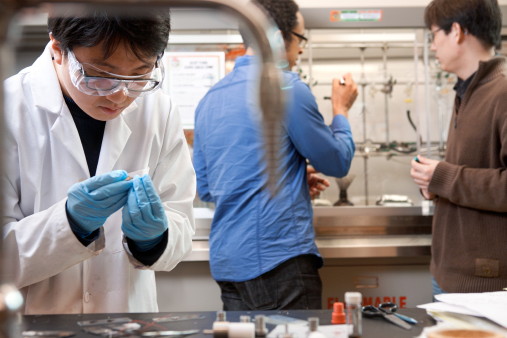
From left, graduate student Don-Hyung Ha, assistant professor Richard Robinson, and postdoctoral associate H.aitao Zhang.
The department is peppered with junior faculty, and half of its graduate students are women. In total, 24 of its graduate students are recipients of prestigious NSF fellowships, of which several were awarded to minority students. Biomedical engineering is just one department that has had success with recruiting female graduate students; for example, chemical engineering has also had 50 percent women Ph.D. students in recent years.
There are, of course, many factors that help biomedical engineering achieve these demographics, says Peter Doerschuk, the department's director of graduate studies. Compared with fields like physics and math, biomedical engineering is relatively new. Though active in the discipline for 50 years, Cornell only established a department in 2004.

Sara Xayarath Hernandez, director of Diversity Programs in Engineering. See larger image
"The interdisciplinary nature is attractive, with the idea of contributing to human welfare, and I think the novelty is attractive, too," Doerschuk surmises. "It is the youngest discipline in the college … We have a much richer diversity situation."
However, when it comes to women faculty, biomedical engineering as a discipline is still a leaky pipeline. According to a 2010 study in Annals of Biomedical Engineering (Vol. 38 No. 5), although the percentage of women in biomedical engineering is higher than many other technical fields, and despite a relatively rich pool of Ph.D. candidates, it is far from being in proportion to the U.S. population.
To seek a balance, faculty members Cynthia Reinhart-King and Claudia Fishbach-Teschl, both assistant professors in biomedical engineering, have started a graduate student women's group in the department. Reinhart-King remembers the first meeting; half of the women were excited, and the other half skeptical. Gender has nothing to do with the fact that we're scientists, they said.
But as a full-time faculty member who is also balancing a family life, Reinhart-King believes in the importance of such groups.
"There are plenty of studies that show that just knowing you are not alone and that you have role models is valuable," she says. "There are definitely concerns at the graduate level, when women are thinking about what kind of job they are going to take, and what will be the effects on their personal life." (See sidebar, page 11.) Other departments, such as materials science and chemical engineering, also have active graduate women's groups.
Diversity as a policy goal
Aggressive recruitment and retention strategies are making their way into college policy. Allmendinger, who oversees the Diversity Programs in Engineering (DPE) office, also is responsible for monitoring all tenure and promotion cases across the college. Throughout the process of recruiting new faculty, he notes, diversity is a unifying and overarching goal – of particular importance as the college hires the next generation of faculty through the universitywide $100 million Faculty Renewal Fund (see related story, page 22).
He is in a position to help junior faculty make the transition to success – for example, making sure they don't become overcommitted, as assistant professors so often do. "I can tell them the most important thing they can do for diversity is to get tenure," Allmendinger says.
He also chairs the college's Strategic Oversight Committee, created in 2007 to monitor the hiring process and keep search committees accountable to good recruiting practices that pay attention to diversity. According to Collins, just having an associate dean for diversity underscores the importance of the issue.
"It gives that person leverage – and that is required – to oversee the searches going on across the whole college," Collins says.
Gone are the days of traditional faculty searches, where a bunch of journal ads sufficed, and "you waited to see who came in," Collins says. "That is a very unlikely way to yield a rich pool of diverse candidates."
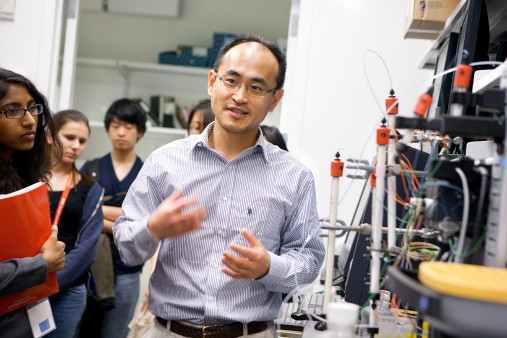
Moonsoo Jin, assistant professor of biomedical engineering, leads a lab tour for prospective engineering students on manipulating molecules and nanotechnology for better detection of cancer.
Instead, Collins says, search committees are expected to consider the word "search" in its truest sense. "They should be using their networks to find candidates out there who are outstanding, maybe at their earliest stages of development, who are not even sure they want an academic career," Collins explains. "They are not the ones who are necessarily going to immediately submit their resumes, but they are qualified potential faculty. We want an active process."
'A broad panorama of populations'
The college's efforts to increase faculty diversity work in tandem with initiatives to recruit and then provide support to a more diverse student body.
"When you look at our programs, they span from pre-college to faculty," says Sara Xayarath Hernandez, director of DPE. "We are looking at a broad panorama of populations, and we are able to leverage opportunities that allow us to intersect programs that target more than one of these populations."
Examples include DPE-run summer programs for high school students: CURIE for women and CATALYST for minorities and first-generation college students. The programs succeed because of undergraduate and graduate students, who work as program assistants, and faculty members, who run field sessions and coordinate research projects.
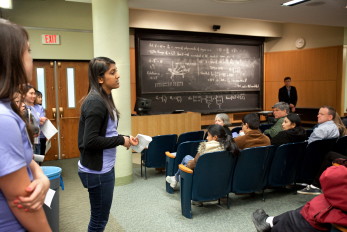
Current students answer questions during Diversity Hosting Weekend. See larger image
There's no magic formula, but departments like materials science and engineering show how emphasizing diversity in recruitment pays off. In the past seven years, the department has hired three women – Chekesha Liddell Watson, Lara Estroff and Delphine Gourdon. Robinson, a minority, was hired in 2008.
Department chair Emmanuel Giannelis credits the department, college and university all working together to provide resources and pay particular attention to creating a diverse pool.
Simple things, he observes, pay dividends. Giving every candidate serious consideration, for one. "If the candidate that you find is strong, but doesn't necessarily fit the limited area you are looking in, are you willing to shift a little bit? … How are you willing to be flexible and go with the opportunities that are presented to you?"
Departments like materials science are helped by their interdisciplinary nature, Giannelis adds. This widens the recruitment field to those who have studied chemistry, physics or mechanical engineering.
Other, more traditional engineering departments face more complex obstacles at all levels – recruiting faculty, all the way down to the undergraduate level. Among women, the problem of leakage in the "pipeline" – the number of Ph.D. candidates with potential to enter academia – is more pervasive in some disciplines. Mechanical engineering and electrical engineering, the two largest Cornell engineering departments, traditionally have had more trouble attracting women students, says Sheila Hemami, professor of electrical and computer engineering.
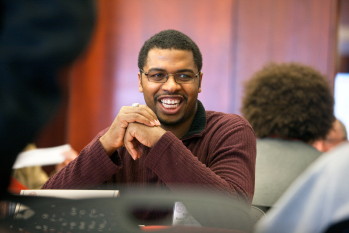
Hakim Weatherspoon, assistant professor of computer science, at the Diversity Hosting Weekend in April. See larger image
Marketing a department's social impact
Hemami also co-directs the CU-ADVANCE center, an NSF-funded initiative to recruit and retain more women faculty in science, technology, engineering and math – the so-called STEM fields – as well as social sciences. She points to the well-understood phenomenon that women, more than men, tend to be drawn to disciplines where they perceive a social impact of their work. This might explain why medical schools have much less difficulty attracting women than, say, graduate fields in mechanical engineering.
"Some engineering disciplines have obvious social impact, like civil and environmental, or chemical and biomolecular," Hemami says. "Some of the others do have equal social impact, but it is not as obvious." So beyond focusing on recruitment and retention strategies, Hemami thinks it's also important for individual disciplines to be better "marketers" – to show students that electrical engineering has as much potential to change the world as any other engineering field.
"If you go into a hospital, every single electrical device in there was designed by an electrical engineer," Hemami notes.
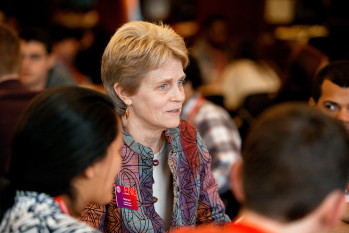
Betsy East, assistant dean for student services in the College of Engineering, speaks with prospective students during the college's joint Prospective Candidates Weekend and Diversity Hosting Weekend. See larger image
The past six years have seen gains in hiring women at Cornell, not only in engineering, but also in the traditionally male-dominated STEM fields, represented by 53 university departments. In 2004 17.7 percent tenured or tenure-track faculty in STEM fields were women; that had increased to 19.3 percent as of 2009-10, according to CU-ADVANCE data.
But sitting back and letting slow demographic shifts gradually increase diversity by attrition is not acceptable, and not enough, warns Paulette Clancy, professor of chemical and biomolecular engineering, who also served as her department's first woman chair, from 2002 to 2010. Improving things like the social climate for women is something that happens the more representation there is, she observes.
And attrition is indeed a slow process. "We have to look at how many we are bringing in minus those leaving," she says. "I think this has contributed to why we are not growing as fast. It's not because we haven't made great efforts. There are a number of reasons why people leave, but if there are any reasons we can fix, we should look into them and make a concerted effort."